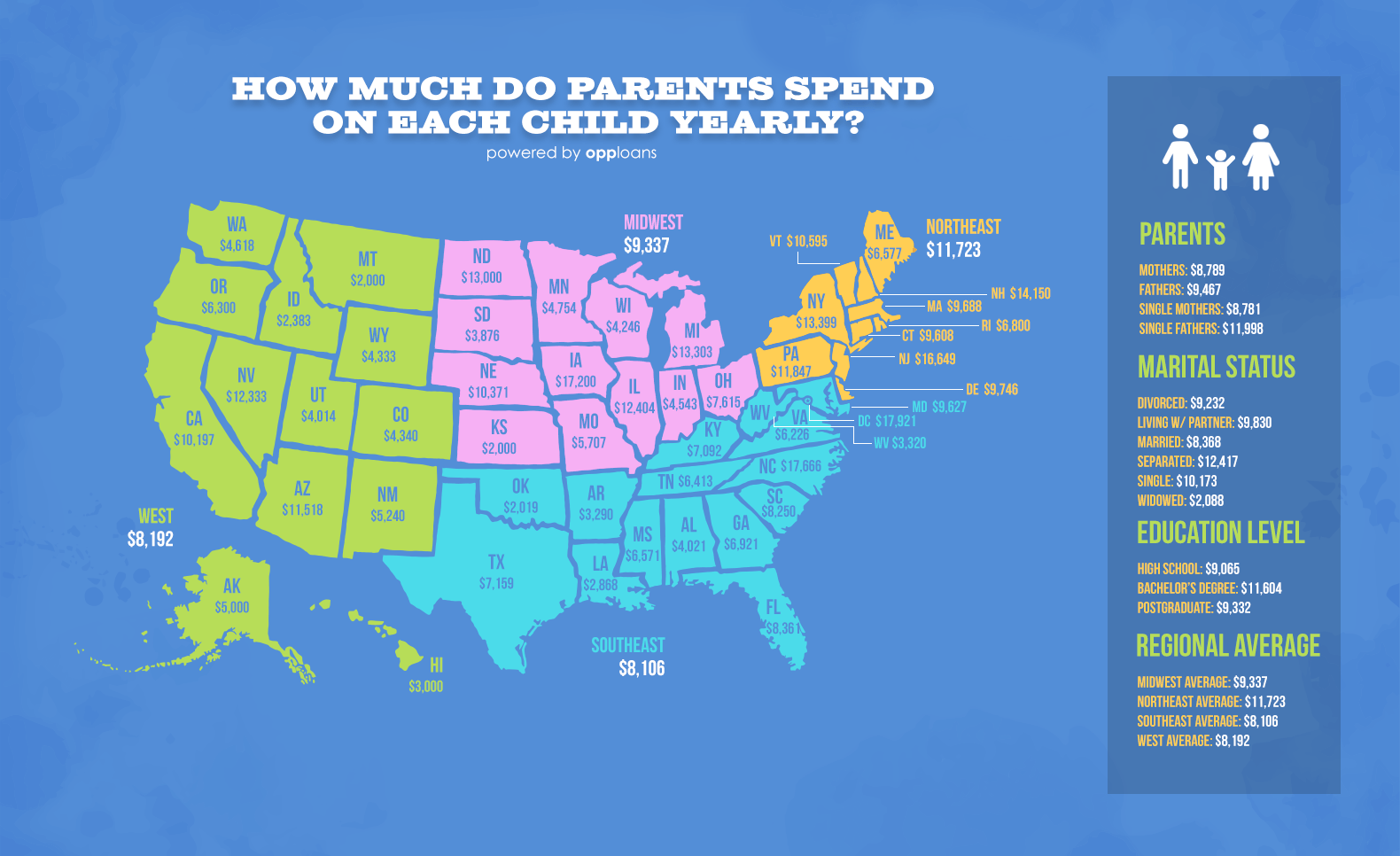How Much Parents Spend on Their Kids State by State

As Mother’s Day approaches (it’s on Sunday, May 13th, in case you’ve forgotten), kids around the country are scrambling to find an acceptable gift for mom. After all, she's spent thousands of dollars on her little rugrats over the years, is it too much to ask for them to drop some cash for some nice flowers or brunch, or at the VERY least, put together an inspired macaroni portrait as a token of their undying appreciation?
To honor the financial burden of motherhood—and fatherhood—we wanted to know just how much money parents were actually spending on their little bundles of joy. So we surveyed more than 1,000 moms and dads from all 50 states and asked them to tell us how much cash they drop on their kids every year. Guys, it turns out that having children is, like, really expensive?? Who knew!
Just how expensive? Across all 50 states, our data found that the average parent spends $9,470 every year on each of their kids, but those numbers can change pretty dramatically depending on where you live. For example, parents in Washington DC spend the most, dropping a hefty $17,920.50 (!!) on each kid annually, while parents in Montana spend the least, at only $2,000 per year.
That's only scratching the surface of what we found! To learn more, check out our awesome infographic below (click to expand) and then keep scrolling for even more tasty tidbits.
(click image to expand)
But what about the epic battle of mom versus dad?
Well, um, here’s where things get a little awkward. See, we initially put this whole thing together to celebrate Mother’s Day, but our research found that it’s actually dads who spend more on their kids per year. According to our survey results, the typical American dad spends about $9,486 annually per kid, while the typical American mom spends just $8,789.
It's not much of a difference, and it can probably be explained by the fact that men, on average, make more money than women. (Or that moms are better are better at budgeting! Take that, DAD!) But still, here’s a fun idea: Bring up this statistic to your mom during Mother’s Day brunch. Just make sure that you remember to duck when she chucks a waffle at your head.
Meanwhile, we also looked at married versus single parents, with single dads out spending single moms by over $3,200 per year: $11,998 to $8,781. On the whole, married parents only spend $8,838 annually per kid, less than single, separated, and divorced parents. Younger parents, between the ages of 18 and 34 spend more on their kids than older parents (which makes sense, cuz babies are pricey).
Parental spending in all 50 states (and Washington DC) ranked.
We broke our survey results down state by state. Below you can see all 50 states and Washington DC ranked from the highest parental spender to the lowest.
| State | Average Spend |
| Washington DC | $17,921 |
| North Carolina | $17,666 |
| Iowa | $17,200 |
| New Jersey | $16,649 |
| New Hampshire | $14,150 |
| New York | $13,399 |
| Michigan | $13,303 |
| North Dakota | $13,000 |
| Illinois | $12,404 |
| Nevada | $12,333 |
| Pennsylvania | $11,847 |
| Arizona | $11,518 |
| Vermont | $10,595 |
| Nebraska | $10,371 |
| California | $10,197 |
| Delaware | $9,746 |
| Massachusetts | $9,688 |
| Maryland | $9,627 |
| Connecticut | $9,608 |
| Florida | $8,361 |
| South Carolina | $8,250 |
| Ohio | $7,615 |
| Texas | $7,159 |
| Kentucky | $7,092 |
| Georgia | $6,921 |
| Rhode Island | $6,800 |
| Maine | $6,577 |
| Mississippi | $6,571 |
| Tennessee | $6,413 |
| Oregon | $6,300 |
| Virginia | $6,226 |
| Missouri | $5,707 |
| New Mexico | $5,240 |
| Alaska | $5,000 |
| Kansas | $4,800 |
| Minnesota | $4,754 |
| Washington | $4,618 |
| Indiana | $4,543 |
| Colorado | $4,340 |
| Wyoming | $4,333 |
| Wisconsin | $4,246 |
| Alabama | $4,021 |
| Utah | $4,014 |
| South Dakota | $3,867 |
| West Virginia | $3,320 |
| Arkansas | $3,290 |
| Hawaii | $3,000 |
| Louisiana | $2,868 |
| Idaho | $2,383 |
| Oklahoma | $2,019 |
| Montana | $2,000 |
North vs. South. No, we’re not talking about the whole United States. We’re talking about North Carolina and North Dakota versus South Carolina and South Dakota.
North Carolina parents are the second highest spenders ($17,666) and North Dakotans are the eighth highest ($13,000). And both spend over $9,000 more than their southern counterparts. South Carolina parents spend $8,250 and South Dakota parents spending only $3,867, ranking 44th.
Basically, if you’re a kid living in South Dakota or South Carolina, do everything in your power to get your parents to move north. Before you know it, they'll be showering you with cash.
We also broke the results down by region. To see exactly which states we counted in each region, check out the infographic above!
| Region | Average Spend |
| Midwest | $9,337 |
| Northeast | $11,723 |
| South | $8,106 |
| West | $8,192 |
Why does the Northeast spend so much more? We’re not entirely sure, but that has never stopped us from speculating wildly. The Northeast is a fairly expensive region of the country, so maybe that $11,723 is really the same as $8,000 once you adjust for incomes and cost of living.
Or maybe it’s because New Englanders are legally required to send their children to ornate, expensive boarding schools covered in parapets and ivy and gargoyles where they play lacrosse and stand on their desks in poetry class and (checks book of “New England Stereotypes”) eat a lot of Dunkin Donuts?
Parental spending by age group, education level, and relationship status.
We did more than ask people about where they live; we also asked them their age, how much education they've received, and whether they are married, divorced, etc. These questions all unearthed interesting trends.
| Age Group | Average Spend |
| 18-24 | $10,056 |
| 25-34 | $10,337 |
| 35-44 | $8,824 |
| 45-54 | $8,312 |
| 54+ | $5,669 |
Parental spending by age is the most straightforward. Younger parents who responded to the survey, ages 18-35, spend more than middle-aged parents, ages 35-54, who spend quite a bit more than parents aged 54 or up.
This makes a lot of sense. Younger parents are pretty much guaranteed to have younger children, who cost more to keep alive and happy than older kids. Meanwhile, parents aged 54 and up are much more likely to have children who are grown adults. At that point, their kids should be spending money on them!
| Relationship Status | Average Spend |
| Divorced | $9,232 |
| Living with partner | $9,830 |
| Married | $8,368 |
| Separated | $12,417 |
| Single | $10,173 |
| Widowed | $2,088 |
The financial hardship of single parenting. Respondents who are married spend less per kid ($8,368) than pretty much any other group—with the notable exception of widowed respondents, who spend way less.
Parents who are divorced spend almost $1,000 per year more per kid ($9,232) than married parents, while parents who are single ($10,173) or are unmarried but living with their partner ($9,830) spend $1,500-$2,000 more than their married counterparts.
Meanwhile, parents who are separated but not divorced spend almost $4,000 than married parents, at $12,417 per year.
All in all, this data points to two-parent households spending less on their kids per partner than split or single parent homes. A two-person parenting unit means that the financial burden doesn’t all fall on one person.
| Education Level | Average Spend |
| High school | $9,065 |
| Bachelor's | $11,604 |
| Postgraduate | $9,332 |
Is that graduate degree really worth it? It probably doesn’t surprise you to see that respondents with bachelor’s degrees had a higher rate of parental spending than respondents with only high school degrees. But what’s going on with parents rocking postgraduate degrees? Their per-child spending is only a few hundred dollars more than parents with just a high school diploma. We can’t be sure, but the high cost of student debt and the dodgy job prospects for some post-grads point to fewer available funds.
Maybe that graduate degree you’ve been considering isn’t worth the high costs? It’s worth thinking about. So is having kids, for that matter. If you’re considering starting a family in the near future, really sit down and figure out the costs of raising a child. In other words, get ready to kiss all your disposable income goodbye.
Oh, and if this post hasn’t convinced you already, make sure you buy your mom something nice for Mother’s day. Look at how much moms are spending on their kids. You owe her.



